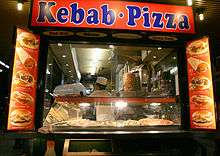Doner kebab
|
Döner meat being sliced from a rotating spit in Istanbul (2012). | |
| Course | Snack or main course |
|---|---|
| Place of origin | Turkey |
| Region or state | Ankara,[1] Bursa, Erzurum |
| Creator | Ottomans (dates to 18th century)[2] |
| Serving temperature | Hot |
| Main ingredients | Lamb, beef or chicken |
| Variations | İskender, Cağ |
|
| |
Döner kebab (/ˈdɒnər kəˈbæb/, /ˈdoʊnər/; Turkish: döner or döner kebap, [døˈnɛɾ ˈcebɑp], in English often spelled doner or donner) is a type of Turkish kebab, made of meat cooked on a vertical rotisserie.[3] Similar dishes cooked on a vertical rotisserie are the Arab shawarma, Greek gyros, and Mexican Al pastor.
Seasoned meat stacked in the shape of an inverted cone is turned slowly on the rotisserie, next to a vertical cooking element. The outer layer is sliced vertically into thin shavings as it cooks.
The sliced meat of a döner kebab may be served on a plate with various accompaniments, stuffed into a pita or other type of bread as a sandwich, or wrapped in a thin flatbread such as lavash or yufka, known as a dürüm. Since the early 1970s, the sandwich or wrap form has become popular around the world as a fast food dish sold by kebab shops, and is often called simply "a kebab". The sandwich generally contains salad or vegetables, which may include tomato, lettuce, cabbage, onion with sumac, fresh or pickled cucumber, or chili, and various types of sauces.
History
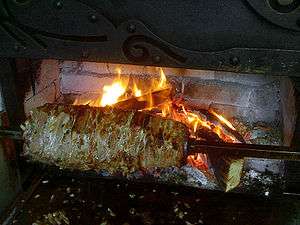
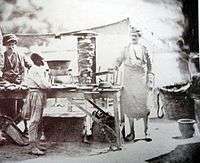
Before taking its modern form, as mentioned in Ottoman travel books of the 18th century,[4][5] the döner used to be a horizontal stack of meat rather than vertical, like the cağ kebabı of Erzurum. Grilling meat on horizontal skewers has an ancient history in the Eastern Mediterranean, but it is unknown when slices of meat, rather than chunks, were first used.
In his own family biography, İskender Efendi of 19th century Bursa writes that "he and his grandfather had the idea of roasting the lamb vertically rather than horizontally, and invented for that purpose a vertical mangal". Since then, Hacı İskender has been considered the inventor of Turkish döner kebap,[6][5] though he might have been preceded by Hamdi Usta from Kastamonu around 1830.[7][8]
With time, the meat took a different marinade, got leaner, and eventually took its modern shape.[5] It was not until a century later, that döner kebab was introduced and popularized in Istanbul, most famously by Beyti Güler. His restaurant, first opened in 1945, was soon discovered by journalists and began serving döner and other kebab dishes to kings, prime ministers, film stars and celebrities.[9] It has been sold in sandwich form in Istanbul since at least the mid-1960s.[10]
The döner kebab, and its derivatives shawarma and gyros, served in a sandwich, came to world-wide prominence in the mid to late 20th century. The first doner kebab shop in London opened in 1966,[11] while Greek-style gyros was already popular in Greece and New York City in 1971.[12]
In Germany, the döner kebab was introduced in 1969 in Reutlingen,[13] before being popularized by Turkish guest workers such as Kadir Nurman in the early 1970s.[14] While the claims of multiple persons to have "invented" the döner may be hard to prove,[15] it is the distinctive style of sandwich that developed there, with abundant salad, vegetables, and sauces, sold in large portions at affordable prices, that would soon become one of the top-selling fast food and street food dishes in Germany and much of Europe, and popular around the world.[16]
Etymology
The English word kebab comes from the Arabic: كَبَاب (kabāb), partly through Urdu, Persian and Turkish. It may refer to a number of different kebab dishes made with roasted or grilled meat. Döner is a Turkish word, from dönmek ("to turn" or "to rotate"). It is sometimes spelled döner kebap, the Turkish spelling, and it literally means "rotating roast".[17] In English, it may also be spelled "doner", "donar", "donair" (in Canada) or sometimes "donner". In German, it is spelled Döner Kebab, which can also be spelled Doener Kebab if the ö character is not available; the sandwich is often called ein Döner. Particularly in British English, a döner kebab sandwich may be referred to simply as "a kebab". In Greece, it was originally called döner (Greek: ντονέρ) but later came to be known as gyros, from γύρος ("turn"), a calque of the Turkish name.[18] The Arabic name شاورما (shāwarmā) derives from another Turkish word, çevirme, also meaning "turning". Persians refer to it as "kebab torki".[19]
Döner in Turkey
There are many variations of döner in Turkey:
- Porsiyon ("portion", döner on a slightly heated plate, sometimes with a few grilled peppers or broiled tomatoes on the side)[20][21]
- Pilavüstü ("over rice", döner served on a base of pilaf rice)[22][23]
- İskender (specialty of Bursa, served in an oblong plate, atop a base of thin pita, with a dash of pepper or tomato sauce and boiling fresh butter)[24][25] "Kebapçı İskender" is trademarked by Yavuz İskenderoğlu, whose family still runs the restaurant in Bursa.[26][27][28]
- Dürüm, wrapped in a thin lavaş that is sometimes also grilled after being rolled, to make it crispier. It has two main variants in mainland Turkey:[29]
- Tombik or gobit (literally "the chubby", döner in a bun-shaped pita, with crispy crust and soft inside, and generally less meat than a dürüm)[31]
- Ekmekarası ("between bread", generally the most filling version, consisting of a whole (or a half) regular Turkish bread filled with döner)[32]
- İskender or "Bursa kebabı"
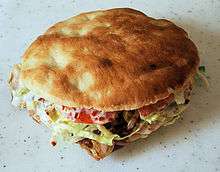
Regional variations
Caucasus, Middle East and Asia
Armenia
In Armenia Ġarsi khorovats, šaurma or in the Armenian diaspora, "Tarna" (literally, "it turns"); it is usually lamb, pork or chicken on a vertical rotisserie, sliced and wrapped in lavaş, served with tahini, yogurt or garlic sauce and with a side dish of pickled vegetables or tourshi.[33]
Azerbaijan
In Azerbaijan, döner kebab (Azerbaijani: dönər), served similarly to the European style of sandwich wrapped in lavaş (flatbread) or in çörәk (bread, including tandoor bread), is one of the most widespread fast foods. It is usually made with әt (meat, essentially lamb or mutton), but sometimes toyuq (chicken).[34][35][36]
Japan
In Japan, döner kebabs are now common, especially in Tokyo. They are predominantly made of chicken but occasionally beef, and called simply "kebab". The toppings include shredded lettuce or cabbage, usually with a choice of sauces such as Thousand Islands, spicy, and garlic, and often sliced tomato.[37]
South Korea
Döner kebab is available throughout much of Seoul, particularly in the foreigner-dominated neighborhood of Itaewon. There are two main varieties: the first, sold from street carts, is modified to suit Korean tastes, with chicken rather than lamb, shredded white cabbage, and honey mustard; the second is offered at permanent takeaways such as Ankara Picnic, Mr. Kebab, and Sultan Kebab, and features a lamb option along with more traditional sauces.
Vietnam
Döner kebab is increasingly becoming popular in Vietnam. Throughout Hanoi and Ho Chi Minh City many döner kebab stalls can be found. Bánh mỳ Döner Kebab, the Vietnamese version of the döner kebab, has some fundamental differences with the original döner kebab. First of all, pork is used instead of beef and lamb. Second, the meat is served in a Vietnamese baguette. Thirdly, the meat is topped with sour vegetables and chili sauce.[38][39]
Europe
Austria
Döner kebab shops can be found in all cities across Austria. Kebabs (often referred to as "Döner") outsell burgers or the traditional Würstel (sausage).[40]
Belgium
Döner kebab restaurants and food stands can be found in almost all cities and smaller towns in Belgium, where they are known as dürüm when served in a wrap. The variety served is similar to that of Germany and the Netherlands. However, it is not uncommon to see döner served with French fries, often stuffed into the bread itself (similar to the German "Kebab mit Pommes"). Many different sauces are typically offered, including plain mayonnaise, aioli, cocktail sauce, sambal oelek or harissa paste, andalouse sauce, "américaine" sauce and tomato ketchup or curry ketchup. Another basic ingredient of the typical Belgian döner kebab is two or three green, spicy, Turkish peppers.
Finland
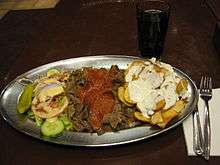
In Finland, döner kebabs have gained a lot of popularity since Turkish immigrants opened restaurants and imported their traditional food. Kebabs are generally regarded as fast food, often served in late-night restaurants also serving pizza, as well as shopping malls.[41] There are over 1000 currently active restaurants that serve kebab foods[42] in Finland, making one kebab restaurant for every 5000 people in mainland Finland.[43]
France
Most kebab shops (themselves known simply as kebabs) are generally run by North African immigrants in France. The basic kebab consists of either "pain de maison" (Turkish soft bread) or "pain arabe" (unleavened flatbread) stuffed with grilled lamb shavings, onions and lettuce, with a choice of sauce from sauce blanche (yogurt sauce with garlic and herbs), harissa (spicy red sauce originally from North Africa), ketchup, or several others. Kebabs are usually served with french fries, often stuffed into the bread itself. In Paris, this variation is called Sandwich grec ("Greek sandwich").[44] Other variations include beef, turkey, chicken, veal, and replacing the Turkish bread with pita bread or baguette.
Germany
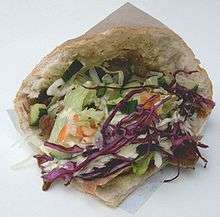
Annual sales of döner kebabs in Germany amounted to €2.5 billion in 2010.[45] Beef or veal, and chicken, are widely used instead of the more expensive lamb. Turkey ("Truthahn") and vegetarian versions are becoming increasingly popular.
Tarkan Taşyumruk, president of the Association of Turkish Döner Producers in Europe (ATDID), provided information in 2010 that, every day, more than 400 tonnes of döner kebab meat is produced in Germany by around 350 firms. At the same ATDID fair, Taşyumruk stated that, "Annual sales in Germany amount to €2.5 billion. That shows we are one of the biggest fast-foods in Germany." In many cities throughout Germany, döner kebabs are at least as popular as hamburgers or sausages, especially with young people.[45]
In 2011 there were over 16,000 establishments selling döner kebabs in Germany, with yearly sales of €3.5 billion.[46]
Netherlands
Döner kebab is available in the Netherlands. As a snack, it is usually served in or with a pita as a "broodje döner" (döner sandwich) with lettuce, onion, tomato slices and sauces, mainly garlic and sambal. The Kapsalon, a dish made with döner meat, french fries, cheese, and salad, originated in Rotterdam.
United Kingdom
Introduced by Turkish immigrants, the döner kebab with salad and sauce is a very popular dish in the United Kingdom, especially after a night out.[15]
Americas
Canada
A variation known as "donair" was introduced in Halifax, Nova Scotia, Canada, in the early 1970s. Peter Gamoulakos migrated to Canada in 1959.[47] When he failed in his attempt to sell traditional gyros, Gamoulakos adapted the dish to local tastes. He substituted beef for lamb and created a sweet sauce known as "donair sauce".[48] Gamoulakos created the donair in 1973. In 2015 Halifax named donair the official food of the city.[49]
Mexico
Al pastor is a variation of döner kebab via Lebanese shawarma. Literally "in the style of the shepherd", it references the lamb often used in shawarma, though it is normally made with pork.[50]
Oceania
Australia
With a multicultural population, the doner kebab in Australia competes with the Greek gyros and the Lebanese shawarma.[51] Kebab sellers are subject to strict government food safety regulations.[52]
Health concerns
Döner kebab is popular in many countries in the form of fast food, often as an end to a night out when preceded by the consumption of alcohol.[53] Health concerns regarding döner kebab, including the hygiene involved in overnight storage and re-heating of partially cooked meat, its quality, as well as high salt, fat, and calorie levels, have been reported in the media.[53][54][55][56] Lean meat, wholemeal bread, and salad, can be considered healthy eating choices, but large amounts of oil-based sauces, added salt, fatty meat, and overly large portions, may contribute to significant health risks.[57]
Some investigations have found poor-quality ingredients in döner kebab meat, or meat types other than what was advertised.[58][59] Food safety regulations in most countries address the dangers of bacteria in undercooked meat of all kinds, sold to the public. Some have guidelines specific to döner kebab handling and preparation. Following several outbreaks of E. coli food poisoning, the Canadian government in 2008 introduced a number of recommendations, including that the meat should be cooked a second time, after being sliced from the rotisserie.[60]
See also
References
- ↑ "Hangi İlimiz Nesiyle Meşhur? ~ Tarihi ve Turistik Yerler".
- ↑ Yerasimos, Marianna (2005). 500 Yıllık Osmanlı Mutfağı (500 Years of Ottoman Cuisine) (in Turkish). Istanbul: Boyut Kitapları Yayın Grubu. p. 307. ISBN 975-23-0111-8.
- ↑ Pawsey, Rosa K. (1 January 2002). "Case Studies in Food Microbiology for Food Safety and Quality". Royal Society of Chemistry. Retrieved 15 August 2016 – via Google Books.
- ↑ "Döner Hakkında – Dönerin Tarihçesi" (in Turkish). Dönercibaşı- Özbilir Grup. Archived from the original on 4 December 2008. Retrieved 3 March 2009.
- 1 2 3 İskenderoğlu, Yavuz. "The Legend Of İskender". Kebapçı İskender. Retrieved 3 August 2016.
- ↑ Kenneth F. Kiple, Kriemhild Coneè Ornelas, eds., Cambridge World History of Food, Cambridge, 2000. ISBN 0-521-40216-6. Vol. 2, p. 1147.
- ↑ Peter Heiner (2008). "Döner in Deutschland: Migration und kulinarischer Wandel". In Markus Ritter; Ralph Kauz; Birgitt Hoffmann. Iran und iranisch geprägte Kulturen: Studien zum 65. Geburtstag von Bert G. Fragner (in German). Wiesbaden: Reichert. p. 427. ISBN 9783895006074.
- ↑ Nail Tan (1990). "Kastamonu'nun ünlü yemek, yiyecek ve içecekleri" [Famous dishes, food and beverages of Kastamonu]. Türk halk kültürü araştırmaları [Turkish folk culture researches] (in Turkish). Vol. 1. Ankara: Halk Kültürünü Araştırma Dairesi [Department of Folk Culture]. p. 109 f.
- ↑ "Three Renowned Turkish Restaurants: Beyti Meat Restaurant". Skylife - Turkish Airlines magazine. No. 12. 2000. pp. 1–4. Archived from the original on 9 February 2012.
- ↑ Eberhard Seidel-Pielen (10 May 1996). "Döner-Fieber sogar in Hoyerswerda" [Doner fever even in Hoyerswerda]. ZEIT ONLINE (in German). Retrieved 6 May 2016.
- ↑ Raziye Akkoc (8 January 2015). "British Kebab Awards: are these Britain's best kebab shops?". Telegraph. Retrieved 6 May 2016.
- ↑ "The Gyro, a Greek Sandwich, Selling Like Hot Dogs". The New York Times. 4 September 1971. p. 23. Retrieved 22 February 2016.
- ↑ "Döner soll aus Schwaben kommen" (in German). n-tv. 15 July 2012. Retrieved 3 August 2016.
- ↑ "From Berlin to the world – the doner kebab". The Local. 31 October 2013. Retrieved 3 August 2016.
- 1 2 James Ramsden (28 October 2013). "Did Kadir Nurman really invent the doner kebab?". The Guardian. Retrieved 6 May 2016.
- ↑ Grieshaber, Kirsten (11 April 2010). "Doner kebab becomes Germany's favorite fast food". USA TODAY. Associated Press. Retrieved 27 February 2016.
- ↑ Peter Heine (2004). Food culture in the Near East, Middle East, and North Africa. Greenwood Publishing Group. p. 91. ISBN 978-0-313-32956-2. Retrieved 5 March 2011.
- ↑ Aglaia Kremezi, "What's in a Dish's Name", "Food and Language", Proceedings of the Oxford Symposium on Food and Cookery, 2009, ISBN 1-903018-79-X
- ↑ Tremblay, Pinar (7 May 2015). "Doner kebab: late-night snack becomes haute cuisine". Al Monitor.
- ↑ "zagkebap.com". zagkebap.com. Retrieved 23 September 2011.
- ↑ Archived 5 March 2009 at the Wayback Machine.
- ↑ Archived 5 March 2009 at the Wayback Machine.
- ↑ farm1.static.flickr.com
- ↑ "Kebapçı İskender – Yavuz İskenderoğlu". Kebapciiskender.com.tr. Retrieved 23 September 2011.
- ↑ Archived 5 March 2009 at the Wayback Machine.
- ↑ http://istanbuleats.com/tag/iskender-ebap/
- ↑ "The Best Iskender Kebab in Istanbul". Culinary Backstreets.
- ↑ "Trademark information for KURULUS 1867 KEBAPÇI ISKENDER from CTM - by Markify". markify.com. Retrieved 15 August 2016.
- ↑ Archived 5 March 2009 at the Wayback Machine.
- ↑ bambicafe.com.tr
- ↑ Archived 5 March 2009 at the Wayback Machine.
- ↑ Archived 5 March 2009 at the Wayback Machine.
- ↑ "Tumanyan Shwarma, Yerevan - Restaurant Reviews, Phone Number & Photos - TripAdvisor". tripadvisor.com. Retrieved 15 August 2016.
- ↑ Nikki Kazimova (2011). Azerbaijan - Culture Smart! The Essential Guide to Customs & Culture. Bravo Limited. ISBN 978-1-85733-548-4.
- ↑ John Noble; Michael Kohn; Danielle Systermans (2008). Georgia, Armenia & Azerbaijan. Lonely Planet. p. 234. ISBN 978-1-74104-477-5.
- ↑ Cesar Weston (2009). "A day in my Azerbaijani Life". Russian Carolina. Archived from the original on 7 February 2013. Retrieved 1 June 2016.
- ↑ Jon Wilks (4 March 2011). "5 to try: Döner kebabs". Time Out Tokyo. Archived from the original on 5 June 2012. Retrieved 1 June 2016.
- ↑ Lauren Shockey (8 November 2009). "Restaurant Review: Banh Mi Doner Kebabs, Hanoi". The New York Times. Retrieved 1 June 2016.
- ↑ Christiane Oelrich (24 February 2010). "Doener kebab culture, refined in Germany, a hit in Vietnam". Monsters and Critics. Deutsche Presse Agentur. Archived from the original on 27 February 2010. Retrieved 1 June 2016.
- ↑ "Punkt" (in German). punkt.kurier.at. Retrieved 23 September 2011.
- ↑ "A kebab restaurant in the mall "Skanssi"" (in Finnish). pernionkebab.fi.
- ↑ "Main page statistics (number of restaurants)" (in Finnish). kebabille.com.
- ↑ "Kebab restaurant densities by municipality" (in Finnish). kebabille.com.
- ↑ Gohar, Laila (16 August 2012). "The Glorious "Le Grec" Sandwich in Paris". foodrepublic.com. Retrieved 15 August 2016.
- 1 2 "Cutting edge robots at Germany's first doner kebab fair". The Independent. Agence France-Presse. 28 March 2010. Retrieved 17 February 2016.
- ↑ (German) FR, accessed 24.9.2011
- ↑ "Best Donair". The Coast. Retrieved 20 February 2012.
- ↑ "Halifax's donair: The tastiest treat you have probably never heard of". theglobeandmail.com. Retrieved 16 August 2016.
- ↑ CBC News (8 December 2015). "Hear ye, hear ye: Halifax declares the donair its official food". CBC News Nova Scotia. Retrieved 8 July 2016.
- ↑ "The Urban Matrix: Mérida - The Lebanese connection :: LOS DOS Cooking school". www.los-dos.com. Retrieved 1 August 2015.
- ↑ "You say kebab, I say yeeros...". sbs.com.au. Retrieved 15 August 2016.
- ↑ NSW Food Authority. "Doner kebabs". Retrieved 15 August 2016.
- 1 2 "How unhealthy is a döner kebab?". BBC News Magazine. 21 January 2009.
- ↑ Guardian Health – Kebab anyone?, The Guardian, 6 October 2006
- ↑ "UK study reveals 'shocking' kebab". BBC News. 27 January 2009.
- ↑ "Results of council survey on doner kebabs". LACORS. 27 January 2009.
- ↑ "How unhealthy is a döner kebab?". BBC News. 21 January 2009.
- ↑ "Keuringsdienst van Waarde".
- ↑ Ivar Brandvol (2007). "Advarer mot billig kebabmat" (in Norwegian). vg.no. Retrieved 27 October 2007.
- ↑ "Health Canada". Health Canada. Retrieved 20 February 2012.
Further reading
- Cardin, Geoff (29 July 2011). "The Dish: Döner Kabob". Feast Magazine. Retrieved 18 April 2013.
External links
-
 Döner kebab at Wikibook Cookbooks
Döner kebab at Wikibook Cookbooks -
 Media related to Döner kebab at Wikimedia Commons
Media related to Döner kebab at Wikimedia Commons - The 10 best döner places in Turkey
